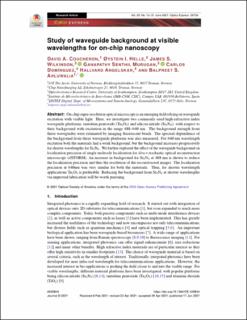| dc.contributor.author | Coucheron, David Andre | |
| dc.contributor.author | HELLE, OYSTEIN I. | |
| dc.contributor.author | Wilkinson, James S. | |
| dc.contributor.author | MURUGAN, GANAPATHY SENTHIL | |
| dc.contributor.author | DOMINGUEZ, CARLOS | |
| dc.contributor.author | Angelskår, Hallvard | |
| dc.contributor.author | AHLUWALIA, BALPREET S. | |
| dc.date.accessioned | 2022-02-08T14:01:13Z | |
| dc.date.available | 2022-02-08T14:01:13Z | |
| dc.date.created | 2021-07-28T21:57:40Z | |
| dc.date.issued | 2021 | |
| dc.identifier.citation | Optics Express. 2021, 29 (13), 20735-20746. | en_US |
| dc.identifier.issn | 1094-4087 | |
| dc.identifier.uri | https://hdl.handle.net/11250/2977767 | |
| dc.description.abstract | On-chip super-resolution optical microscopy is an emerging field relying on waveguide
excitation with visible light. Here, we investigate two commonly used high-refractive index
waveguide platforms, tantalum pentoxide (Ta2O5) and silicon nitride (Si3N4), with respect to
their background with excitation in the range 488–640 nm. The background strength from
these waveguides were estimated by imaging fluorescent beads. The spectral dependence of
the background from these waveguide platforms was also measured. For 640 nm wavelength
excitation both the materials had a weak background, but the background increases progressively
for shorter wavelengths for Si3N4. We further explored the effect of the waveguide background on
localization precision of single molecule localization for direct stochastic optical reconstruction
microscopy (dSTORM). An increase in background for Si3N4 at 488 nm is shown to reduce
the localization precision and thus the resolution of the reconstructed images. The localization
precision at 640nm was very similar for both the materials. Thus, for shorter wavelength
applications Ta2O5 is preferable. Reducing the background from Si3N4 at shorter wavelengths
via improved fabrication will be worth pursuing. | en_US |
| dc.language.iso | eng | en_US |
| dc.publisher | Optica Publishing Group | en_US |
| dc.title | Study of waveguide background at visible wavelengths for on-chip nanoscopy | en_US |
| dc.type | Peer reviewed | en_US |
| dc.type | Journal article | en_US |
| dc.description.version | publishedVersion | en_US |
| dc.rights.holder | © 2021 Optical Society of America under the terms of the OSA Open Access Publishing Agreement | en_US |
| dc.source.pagenumber | 20735-20746 | en_US |
| dc.source.volume | 29 | en_US |
| dc.source.journal | Optics Express | en_US |
| dc.source.issue | 13 | en_US |
| dc.identifier.doi | 10.1364/OE.420844 | |
| dc.identifier.cristin | 1922923 | |
| dc.relation.project | Norges forskningsråd: 285571 | en_US |
| cristin.ispublished | true | |
| cristin.fulltext | original | |
| cristin.qualitycode | 2 | |
